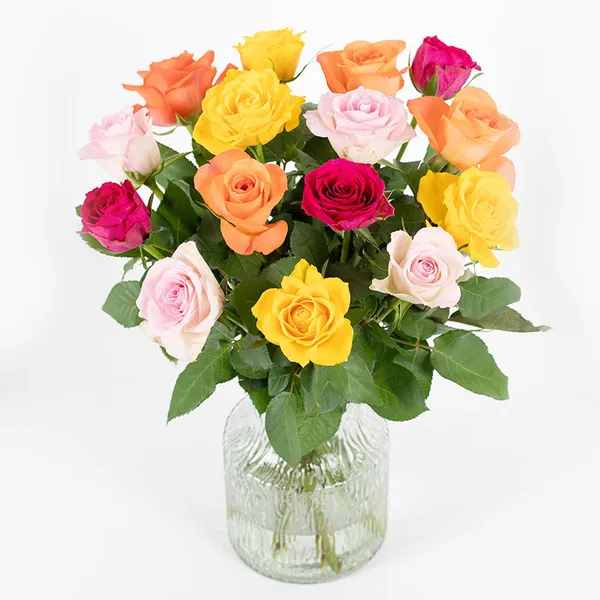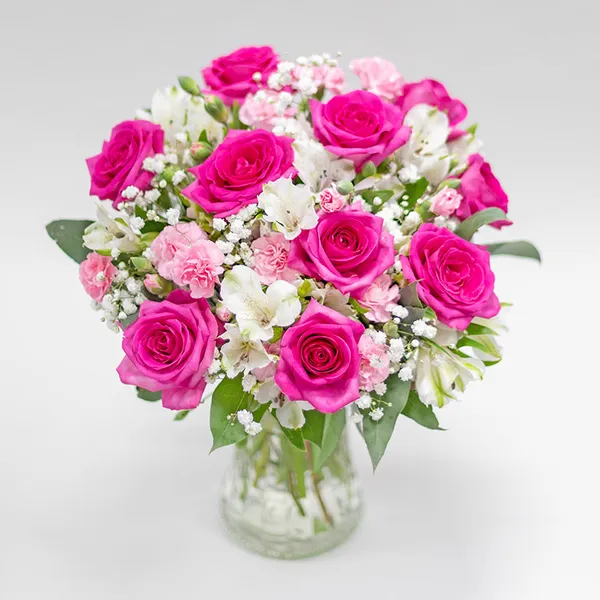Roses: The Timeless Symbol of Love and Beauty
Roses are perhaps the most iconic and universally recognized flowers, celebrated for their beauty, elegance, and rich fragrance. They symbolize love, passion, and romance, making them a timeless choice for bouquets, celebrations, and special occasions. With over 150 species and thousands of hybrids, roses come in a stunning variety of colors, each with its own unique meaning. From classic red roses that express deep love to delicate white roses symbolizing purity, roses hold a unique place in gardens and floral arrangements worldwide.
COMMON NAME
Rose
BOTANICAL NAME
Rosa spp.
ORIGIN
Asia, Europe, North America, and Africa
PEOPLE ALSO CALL IT
Queen of Flowers
FLOWERING TIME
Late spring through fall (May to October)
ASPECT
Full sun
SYMBOLISM
Love, passion, beauty, purity, and friendship
Care Tips for Cut Roses in a Vase
Trim Stems at an Angle: Re-cut the stems at a diagonal under water to prevent air bubbles and improve water absorption.
Remove Lower Leaves: Strip any leaves that would sit below the waterline to avoid bacterial growth.
Change Water Regularly: Replace the water every two days and add flower food to nourish the roses.
Keep Cool: Place the vase in a cool spot away from direct sunlight, heat sources, or drafts.
Prune Fading Blooms: Remove any wilting flowers or petals to encourage the remaining blooms to last longer.
Symbolism and Meaning
Roses are rich in symbolism, with the meaning varying depending on the colour and number of stems.
What does the colour of a rose mean?
Dark pink roses express gratitude. Are you grateful for your partner for something specific or just for having them in your life? Dark pink roses are the best way to express it.
Pink roses symbolise youth, lovingness and beauty - these three qualities make them the perfect gift at the beginning of a relationship.
Red roses represent love and passion. Most of us traditionally give them as gifts for Valentine's Day or anniversaries. Are you sure of your love and do you believe in a future together? Choose red roses to express exactly that.
White roses represent shyness. Do you find it challenging to show your feelings or even put them into words? Let white roses speak for you.
Yellow roses have different meanings for different relationships. Giving yellow roses to a romantic partner means there was a problem and act as a way to forgiveness. However, if you give yellow roses to friends, they have a different meaning. Here they stand for fun, friendship and gratitude - a great gift for good friends.
Orange roses stand for desire and passion.
Lavender roses represent love at first sight. Perfect for Valentine's Day, or an anniversary!
Red and yellow roses together stand for joy, happiness and excitement. Has something exciting recently happened in your relationship? Roses in red and yellow express your joy and happiness.
Light pink roses mean desire, joie de vivre, youth, energy. Are you in a young relationship with lots of energy joy of life? Underline this wonderfully with light pink roses.
What does the number of roses mean?
1 rose = Love at first sight
2 roses = Mutual love
3 roses = I love you
5 roses = I'll do anything for you
6 roses = I am yours
7 roses = I love you
9 roses = Eternal love
10 roses = You are perfect
15 roses = I'm sorry
20 roses = I want to be honest with you
40 roses = My love for you is sincere
50 roses = Love without regret
99 roses = I love you until the end of my life
100 roses = Harmonious love
101 roses = You are my only love
108 roses = Marry me!
365 roses = I think of you every day
999 roses = Eternal love and immortality
Types of Roses
Roses come in a wide variety of types, each with unique qualities and uses, from formal gardens to floral arrangements. Here's a closer look at the most popular classes of roses:
Hybrid Tea Roses are renowned for their large, elegant, and high-centered blooms, often displayed as a single flower on long stems. These roses are a staple in floral arrangements, highly popular in gardens, and can also be preserved as keepsakes, making them a timeless choice for cut flowers.
Floribundas are known for their clusters of smaller flowers, which bloom prolifically throughout the season. Compared to hybrid teas, they are generally more compact and offer a longer blooming period, making them ideal for garden borders and mass planting.
Grandifloras are a cross between hybrid teas and floribundas, combining the best of both groups. They produce large, showy flowers in clusters, offering the elegance of hybrid teas with the abundant blooms of floribundas. Their tall, sturdy stems make them perfect for adding height and drama to gardens.
Climbing Roses are known for their long, trailing canes that can be trained to grow on trellises, arbors, fences, or walls. Their ability to climb and spread makes them a stunning choice for vertical spaces, adding a romantic and whimsical touch to any garden.
Miniature Roses are small in size but offer all the beauty and charm of larger rose varieties. Their compact growth makes them perfect for pots, containers, and small garden spaces, while their delicate blooms add a splash of color to borders and edges.
Shrub Roses encompass a diverse group of roses that are hardy, versatile, and easy to care for. They come in various shapes and sizes, from low-growing varieties to sprawling bushes, making them an excellent choice for landscaping and informal gardens.
Old Garden Roses, also known as heritage or antique roses, are varieties that predate modern hybrid roses (introduced after 1867). These roses are cherished for their strong fragrance, classic shapes, and timeless beauty. They often have a natural, romantic charm that evokes the elegance of bygone eras.
Frequently Asked Questions About Roses
Prune your roses in late winter to early spring (February to March) when the plant is still dormant but showing signs of new growth. In areas with mild winters, pruning can be done earlier.
For repeat-flowering roses, light pruning can also be done in summer after the first bloom to encourage a second flowering.
This is how you prune roses:
- Clean your tools: Use sharp, clean pruning shears to prevent disease.
- Remove deadwood: Cut out all dead, damaged, or diseased wood.
- Shape the plant: Cut stems back to about 1 cm above an outward-facing bud to encourage open growth.
- Thin the center: Remove weak and crossing branches to improve airflow and reduce disease risk.
- Pruning by type:
- Hybrid tea roses: Prune back to about 30-45 cm.
- Shrub roses: Remove up to one-third of the oldest stems.
- Climbing roses: Cut back side shoots to 2-3 buds and remove damaged canes.
This is how you fertilise your roses:
- Start fertilizing in early spring when new growth appears. Use a balanced rose fertilizer (10-10-10 or 5-10-5).
- Apply fertilizer again after the first bloom to support repeat flowering.
- Avoid late-season fertilizing: Stop fertilizing 6-8 weeks before the first frost to prevent tender growth that could be damaged by cold.
No, roses (Rosa species) are not toxic to cats. However, the thorns can cause injury, and ingestion of leaves or petals may cause mild stomach upset.
- Cut roses: With proper care, cut roses last 5-10 days in a vase.
- Garden roses: Depending on the variety and weather, rose blooms can last anywhere from 1-3 weeks on the plant. Repeat-flowering roses produce blooms multiple times through the season.
- Plant bare-root roses in late autumn to early spring.
- Container roses can be planted any time, but spring and autumn are best for root establishment.
This is how you tackle greenflies on your roses?
- Spray roses with a strong stream of water to dislodge greenflies.
- Use natural predators like ladybirds.
- Apply an insecticidal soap or neem oil solution to control infestations.
Black spots on your roses are most likely casued by a fungal disease called Diplocarpon rosae.
This is how you should treat it:
- Remove and dispose of infected leaves.
- Improve airflow and avoid wetting foliage.
- Use a fungicide like sulfur or copper spray regularly.
Roses can be propagated through:
- Cuttings: Growing new plants from stem cuttings.
- Layering: Bending stems to root while still attached to the parent plant.
- Grafting: Combining rootstock with a rose cutting.
- Take a 15-20 cm cutting from a healthy, non-flowering stem.
- Remove the lower leaves, keeping 2-3 at the top.
- Dip the cut end in rooting hormone.
- Plant the cutting in moist soil or sand.
- Cover with a plastic bag or dome to retain humidity.
- Place in indirect light and keep the soil moist until roots develop.
Use sharp pruners to cut a 15-20 cm section of a healthy stem just below a leaf node. Remove lower leaves and buds. Follow the same steps as in propagation to encourage root growth.
Causes:
- Lack of water or heat stress.
- Air bubbles in the stems (cut roses).
- Disease or pests.
Solutions:
- Recut the stems under water at an angle and place them in fresh, cool water.
- For potted or garden roses, water deeply and check for pests or diseases.
This is how you press roses in 4 easy steps:
- Remove excess leaves.
- Place the rose or petals between parchment paper.
- Press in a heavy book or flower press.
- Leave for 1-2 weeks until completely dry.
Roses bloom from late spring to early autumn. Repeat-flowering varieties bloom multiple times throughout the season, while old garden roses bloom once in early summer.
Botanically speaking, roses have prickles, not thorns. Prickles sit on the surface of the stem and are easy to remove, while thorns are firmly embedded in the tissue.
Yes, but it’s not ideal. Uprooting roses during flowering stresses the plant. If necessary, transplant them carefully with as much root ball as possible and water thoroughly.
Water your roses deeply 1-2 times per week, depending on the weather and soil. Avoid superficial watering, as this can weaken the roots.
Strongly scented varieties include:
- Damask roses
- English roses (e.g. David Austin varieties such as ‘Gertrude Jekyll’)
- Old garden roses such as Bourbon roses, centifolia roses and moss roses.
No, roses are not toxic to dogs. However, the thorns may cause cuts, and eating large amounts may lead to digestive irritation.
For cut roses:
- Trim stems at an angle under running water.
- Use a clean vase filled with cool water and floral food.
- Remove any leaves below the waterline.
- Change the water every 2-3 days.
- Keep roses in a cool place away from sunlight, heat, or ripening fruit.
For garden roses:
Regular deadheading (removing spent flowers) extends the flowering period.
Choosing the right roses
Getting the right roses is a key factor in how your dried flowers turn out. Look for ones that are in that "almost there" stage – not fully bloomed, but showing off their colours nicely. These are the roses that will hold up best when you dry them.
As for colour, darker roses tend to keep their hues better than lighter ones when dried. Among these, hybrid tea roses stand out. These typically have long, slender stalks with one large, high-centred flower per stem, making them a favourite choice for cut flowers and floral arrangements.
Drying rose heads (whole roses)
Here's the lowdown on drying complete rose blossoms — everything from the petals to the bud in the centre.
How do you preserve roses for keepsake?
- Choose your roses: Select roses that are at their peak of their freshness, just before they fully open. This is when they have the most vibrant colours and are least likely to wilt during drying.
- Prepare roses: Take your time to trim away any extra leaves, pesky thorns, or petals that have seen better days. This helps the drying process go smoothly and keeps your roses looking pristine.
- Tie roses together: Group the roses into small bundles (usually three to five roses per bundle) and tie them together with string or twist ties. Ensure they are tightly secured so they won't slip down.
- Hang roses upside down: Hang the bundles of roses upside down in a dark, dry, and well-ventilated room. This can be a cupboard, attic, or any place where they won't be exposed to direct sunlight. Doing this allows the roses to maintain their shape and prevents wilting.
- Be patient: Let the roses air dry for around two to four weeks — the drying time can vary depending on the humidity and conditions of your drying area.
- Enjoy: After drying, carefully remove the strings or twist ties. Your dried roses are now ready to use for crafts, arrangements, or other decorative purposes.
How long do dried roses last?
Dried roses can retain their shape, colour, and beauty for several years. Over time, they may become more fragile, but with gentle handling and protection from dust and moisture, they can serve as a keepsake for a long time.
How do you dry roses to keep them forever?
Forever is a pretty long time, but using silica gel to dry roses is a great way to keep their beauty intact for years to come. Here’s how to do it:
- Prune: Begin by pruning your roses as you would for normal air drying.
- Prepare gel: Take a shallow, airtight container and add a layer of silica gel (a desiccant that removes moisture) about one to two inches deep.
- Cover: Gently bury the roses in the gel, ensuring they are evenly spaced and not touching each other, before carefully pouring more silica gel over the roses until they are completely covered. Be sure not to press or bend the petals during this process.
- Seal: Once the roses are covered, seal the container with an airtight lid.
- Dry: Allow the roses to air dry for approximately two to four weeks.
Over this time, the gel will gradually absorb moisture from the flowers, effectively preserving them a long time.
Drying rose petals instead of rose heads has some differences in the process and uses. Here's what you need to know:
What can you do with dry rose petals?
There are many delightful ways to make the most of dry rose petals. You can toss them into the bath for a relaxing soak, mix them up with some dried herbs, flowers, spices, and essential oils to make some potpourri, or even sprinkle edible rose petals into your cooking and baking.
How do you dry rose petals naturally?
- Harvest the rose petals: Choose roses that are almost fully bloomed but not overripe. Gently pluck the petals from the roses, making sure to remove any damaged or discoloured petals.
- Spread the petals: Spread the rose petals in a single layer on greaseproof paper on a tray. This will allow for good air circulation.
- Let them dry naturally: Place the tray with the rose petals in a cool, dark, and dry room. Avoid direct sunlight, as it can cause the petals to lose their colour.
- Check and turn them: Check the petals daily and gently turn them over to ensure even drying. This helps prevent mould or moisture from accumulating.
- Store: Once the rose petals are completely dry, store them in an airtight container or a resealable bag. Keep them in a cool, dark place away from moisture and sunlight to maintain their fragrance and colour.
Unfortunately, roses lose their original fragrance during the drying process. But if you want your keepsake to have a scent of its own, you can always add a few drops of essential oil to the dried flowers.


